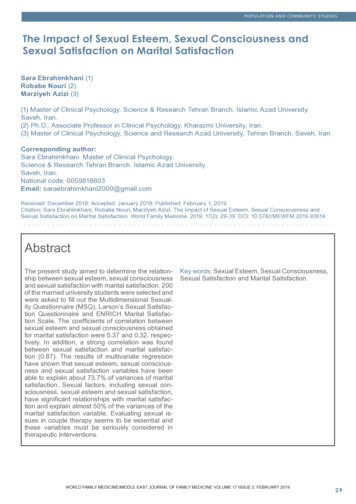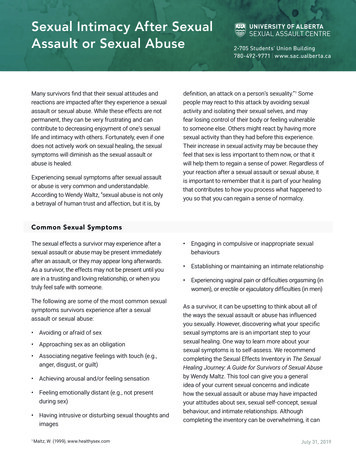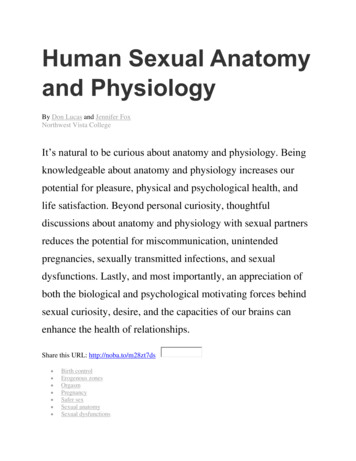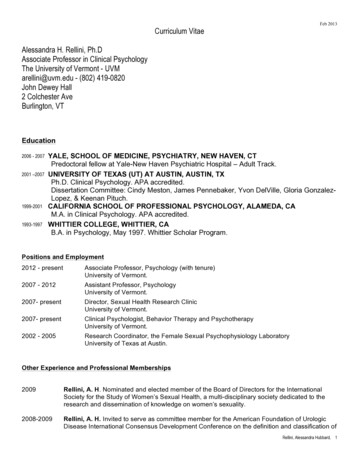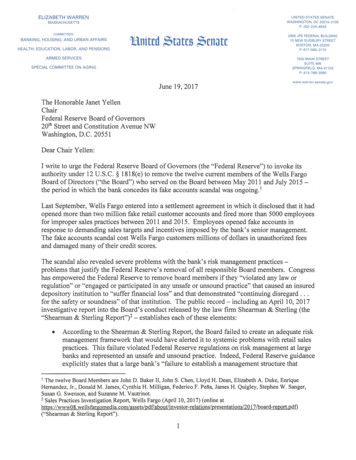
Transcription
Montana Journalism ReviewVolume 1Issue 42 Issue 42, 2013Article 1Summer 2013Breaking Scandal: Inside the Sexual AssaultCoverage, The Jezebel Reporter's DefenseUniversity of Montana School of JournalismFollow this and additional works at: http://scholarworks.umt.edu/mjrPart of the Journalism Studies CommonsRecommended CitationSchool of Journalism, University of Montana (2013) "Breaking Scandal: Inside the Sexual Assault Coverage, The Jezebel Reporter'sDefense," Montana Journalism Review: Vol. 1: Iss. 42, Article 1.Available at: http://scholarworks.umt.edu/mjr/vol1/iss42/1This Full Issue is brought to you for free and open access by ScholarWorks. It has been accepted for inclusion in Montana Journalism Review by anauthorized administrator of ScholarWorks. For more information, please contact scholarworks@mail.lib.umt.edu.
MRJSchool of Journalism: Breaking Scandal: Inside the Sexual Assault Coverage, The JezebelSUMMER 2013BREAKINGSCANDALInside the Sexual Assault CoverageThe Jezebel Reporter’s DefenseISSUEDUI FASHION:ANKLE BRACELETSTAKE OFFPublished by ScholarWorks, 2015WITH MOMSIN PRISON,ROOMMATES BONDHELP! REALITY TVGOES MONTANA42University of MontanaSchool of Journalism1
Montana Journalism Review, Vol. 1 [2015], Iss. 42, Art. 11http://scholarworks.umt.edu/mjr/vol1/iss42/12
School of Journalism: Breaking Scandal: Inside the Sexual Assault Coverage, The JezebelCONTENTSCOVER STORY: THE BLAME GAME 23TWO NATIONS,ONE VOICE13-174 LETTER FROMTHE EDITORS7-10 YEAR IN REVIEWTHE NEW 11BALL AND CHAIN18 RUNNING ON EMPTYLIGHTWEIGHT HEROES 22YOU’VE BEEN SERVED 362Published by ScholarWorks, 20153
Montana Journalism Review, Vol. 1 [2015], Iss. 42, Art. 146 LOOKING DOWNTHE BARREL45 OUT OF THE ABYSSWATCHDOG 50-5539HOW A NIGHTCAN GO WRONG48 FALLING FARFROM THE TREE56-62MADE IN /14
School of Journalism: Breaking Scandal: Inside the Sexual Assault Coverage, The JezebelLETTER FROM THE EDITORSDear readers:The objects you see in the mirror are not as close as they appear.Behold Montana, cherished for its closeness to nature and its lackof people. Outsiders know no better place to escape. Insiders valueits close-knit communities.That is until nature proves treacherous, crime separates families,and communities fracture. Once intimacy dissolves into multipledegrees of separation, closeness becomes difficult to navigate fromthe inside.The sexual-assault scandal at the University of Montana strippedMissoula naked in front of national news audiences. Die-hardfootball fans started ripping each other apart on the Web. It was atouchy situation for local journalists, who cover a community thatprides itself on a legacy of peaceful coexistence between liberals andloggers.Even beyond the scandal, many stories in this issue examinedimensions of closeness between journalists, sources, audiences,and bosses. How close is too close? How tight is the leash, fromhigh school journalism to a sports reporter speaking truth on socialmedia?The closer our writers looked at the mirror, the morecontradictions appeared. Take the development of natural resources,which benefits far-flung communities, but destroys the very naturethat distinguishes our state. Montana’s alliances to conserve naturereach beyond party lines and geographical borders. Yet conservationefforts can make the land itself too expensive to live on.Among Montanans, and the people who love Montana, there’sa temptation to hark back to an imaginary time when closemeant whole. There’s the hope that the media will stop lookingfor contradictions and start building community, glossing overdifferences instead of fueling debate.In the wake of scandal, Missoulians ached to put the troublesbehind them and start from scratch, like the pioneers.But as tempting as it might be to seek closure, that’s not whatthis magazine has ever been about. There are countless shades ofcloseness and separation. As journalists, it’s our job to reveal them.Objects in the mirror are closer than they appear. We hope youenjoy the 2013 edition of Montana Journalism Review. We welcomeyour feedback.Henriette Lowisch, editor-in-chiefBillie Loewen, managing editor4Published by ScholarWorks, 20155
Montana Journalism Review, Vol. 1 [2015], Iss. 42, Art. 1MRJABOUTLed by journalism students at theUniversity of Montana, the nation’s firstjournalism review is back to analyze thework of the state’s media and informits readers about the issues that mattermost to Montanans.Featuring Watchdog, Made in Montana and Year in Review sections, MJRaccentuates quality student productionwith media analysis. The magazine alsodelves into non-media oriented newsand trends to showcase journalismtaught and practiced in the TreasureState.While last year’s issue focused onbooms and busts, this year’s editionexplores closeness in all its dimensions.MJR covers all areas of the state, fromthe mountains to the prairies. Foundedby dean Nathaniel Blumberg in 1958,it went into hiatus from 1979 to 1993,when professor Clem Work reinstatedit. Since 2012, professor HenrietteLowisch has mentored students throughMJR’s production. We’re grateful toMatt Gibson for his ongoing sponsorship of our print edition.MJR also produces online content inan effort to be transparent and broadenperspectives, engaging readers on Facebook and Tumblr. For a free subscription, please go to our website mjr.jour.umt.edu/Both the print and web editions areexclusively conceived, edited, designedand produced by advanced journalismstudents. All rights remain with theauthors of the works published ine Glass andTobacco Products123 W Main St, Missoula, MT 59802Open DailyMon-Sat 10-10 and Sun 12-8(406) 2/16
School of Journalism: Breaking Scandal: Inside the Sexual Assault Coverage, The JezebelWelcome Hasler Customers!Neopost USA is proud to offerthe myNeopost service to ourHasler customers as part of ourongoing efforts to provide asingle, comprehensive customerservice experience!Want more information and content fromMONTANA JOURNALISM REVIEW?Visit our websiteMJR.JOUR.UMT.EDUMailing Systems Plus More“The only authorized Neopost Dealer in the Missoula area”Toll Free: 800-590-6222 Helena: 406-442-6222 Missoula: 406-549-0089IS-6000THE NEW CHOICE IN HIGH VOLUME MAILINGErgonomically Engineered for Maximum Productivity and OutputPublic service broadcasting fromThe University of Montanastreaming at mtpr.orgmontanapbs.orgIndie arts and humanitiesOnline Magazinewww.IndieItPress.comWhere we share indie artists’ creations and journeys.View Montana Public NoticesFree Online!www.publicnoticeads.com/MTN E W S PA P E RA S S O C I AT I O NA free service provided by newspapers of the6 Montana Newspaper Association.Published by ScholarWorks, 2015 7
Montana Journalism Review, Vol. 1 [2015], Iss. 42, Art. 1PHOTO BY AMY SISKYEAR IN REVIEWBIGMACBOOMOil fields bring real money for fake foodIn our last issue, “Boom: Reporting on natural resources in Montana,”we debunked the claim that a fast-food gig can earn you 17 per hourin the Bakken. Still, there’s more money to be made back east than in aMontana university town. Vern Brekhus, manager of the local McDonald’sin Williston, North Dakota, said he is always looking to hire more people todeal with increased traffic from the recent oil boom. Employees start at 11an hour, but can quickly see raises of up to four dollars per hour.“If they’re a good quality employee, we’ll move them up pretty fast,”Brekhus said.In Williston, many people take jobs at fast food restaurants or retail storeswhile waiting for interviews with oil companies. Cindy Sanford of WillistonJob Services said her office has helped people from all 50 states, everyCanadian province, and at least six different countries. In February, JobsServices saw an average of 93 people per day.They might be spending faster than they’re making, however: Rent for abasic one-bedroom apartment in Williston can be as high as 2,300 a month,compared to an average of 787 in Bozeman and 653 in Missoula.-Jackson BolstadPHOTO BY LARRY MAYERWAITING FOR JUSTICETwo men to stand trial for the murder of Sherry ArnoldTwo Colorado men sit in eastern Montana jail cells awaiting trial for themurder of Sherry Arnold. The Sidney High School math teacher disappearedin January 2012 after she left her home for a morning jog.Early on the morning of January 7, 2012, Lester Walters and MichaelSpell allegedly spotted Arnold running alongside a field that was slated tobecome the site of a new housing subdivision for oil workers. According toan affidavit filed in Richland County District Court, Spell knocked Arnolddown, choked her out, and pulled her body into a Ford Explorer. Authoritiesdiscovered Arnold’s remains two months later, buried in a field across theNorth Dakota border.The two men face charges of deliberate homicide and attempted kidnapping. Their trials are set for November 2013 and January 2014. If convicted,they could face the death penalty.Arnold’s death sent shockwaves through Sidney, a small town located at theepicenter of the Bakken oil boom in Montana. Weapons flew off the shelvesat gun stores and a record number of women enrolled in self-defense classes.More than a year has passed since the day Arnold left her home for a jog.The community is still healing, but they are joined by supporters across theworld – even some as far away as Spain – who have organized annual runs tohonor her memory.-Amy Sisk7http://scholarworks.umt.edu/mjr/vol1/iss42/18
School of Journalism: Breaking Scandal: Inside the Sexual Assault Coverage, The JezebelCLOSE QUARTERSMissoulians quarreled for most of 2012 over a proposed ordinance thatwould legalize rental additions known as accessory dwelling units (ADUs)throughout the city.ADUs, which can either be interior basement and attic apartments orexterior backyard cottages, are prohibited in single-family neighborhoods likethe University District and the South Hills.Proponents argue the ordinance would increase convenient, affordablehousing options in Missoula, which suffers from a rental-vacancy rate wellbelow the national average.Opponents have been persistent and vocal in their resistance, contendingADUs will change the character of neighborhoods. Increased parkingproblems, trashy yards, and noisy neighbors are some of the biggest issuesopponents say ADUs will bring to already crowded neighborhoods.Supporters of the ordinance don’t buy the gripes. They are quick to citean owner-occupancy requirement, which they say would help keep unrulyrenters in check.In addition, supporters say ADUs are prevalent throughout the city already,but many of them are illegal and not up to code. Lifting the ban could lead tosignificant upgrades on the existing ADUs.Overall, the matter has consumed time and money from both sides.Public outreach programs and staff time will have cost the city about 20,000 by spring of this year. On the other side, opponents pooled morethan 10,000 for a petition, hoping to force a two-thirds supermajority voteby city council to pass the ordinance.-Brett BerntsenMissoula County debates whether to allowurban neighborhood homeowners to build‘granny flats’ to cope with Missoula’slower-than-average housing vacancy ratesPHOTO BY ERIC ORAVSKYPHOTO BY DAMEON MATULEMONTANA POLITICIANS ENDORSE KEYSTONE XLDuring the 2012 election campaign, every Montana politician of nationalambition endorsed it.This past spring, even the local newspaper of thenotoriously liberal college town of Missoula came out in favor. Based on popularsentiment in one of the least important states in the union, President BarackObama’s final approval of the Keystone XL Pipeline seemed pretty much a given.TransCanada’s new pipeline will cross three states – Montana, South Dakota,and Nebraska — before joining the existing pipeline near Steele City, Nebraska.It would cover 875 miles of land (as opposed to an earlier proposal’s 1,384 miles)to transport crude oil from Alberta, Canada, and the Bakken Shale Formation inMontana to Cushing, Oklahoma, and the Gulf Coast region of Texas.In December 2012, the Montana Land Board approved 50-year easements forthe pipeline to cross state-owned land.Those opposed to the easements pointedout that the pipeline would cross the Missouri and Yellowstone rivers.This couldlead to an evironmental disaster, like on March 27, 2012, when a CanadianPacific train derailed in Minnesota, leaking an estimated 20,000 to 30,000 gallonsof crude oil onto the frozen prairie.The opposition’s main concern regarding the pipeline is that it supports tarsand development in neighboring Canada, thus fueling climate change.Tony Hartshorn, an assistant professor in the Department of Land Resourcesand Environmental Science at Montana State University, said tar sand drillingcontributes to greenhouse gasses such as carbon dioxide and water vapors, whilealso thinning the forest keeping those emissions in check.Climate change, however, still isn’t an issue that has much traction in Montana.After all, Glendive isn’t NewYork, and the state hasn’t had any natural disasterslike Hurricane Sandy — yet.-Hanah Redman8Published by ScholarWorks, 20159
Montana Journalism Review, Vol. 1 [2015], Iss. 42, Art. 1PHOTO BY AMY SISKYEAR IN REVIEWDARK MONEY CASTS SHADOW OVER2012 MONTANA ELECTIONSAn unprecedented amount of money entered the 2012 Montana electionsthanks in part to a June 2012 U.S. Supreme Court decision that struck downthe state’s century-old ban on corporate campaign contributions.An analysis of campaign finance records by the Associated Press showedthat a record 47 million poured into the 2012 U.S. Senate race between JonTester, Democrat, and Denny Rehberg, Republican. That amount includesdirect contributions, as well as 25 million from unions, business groups, andpartisan committees. Six years earlier, the race for the same Senate seat drewjust 17.5 million in spending.The SCOTUS ruling overturned the Montana Supreme Court’s decision touphold the state’s campaign finance regulations, which citizens voted into lawin 1912 to crush the political influence of mining barons.Corporations and unions could now make unlimited political expendituresin state elections, reminding some of the early 20th-century political landscape, when Montana copper kings bought and bribed their way into power.The Citizens United decision is wildly unpopular in Montana. More than70 percent demanded that it be overturned, endorsing an initiative on theNovember 2012 ballot.In 2013, Montana legislators grappled with the best way to move forward,voting on a number of proposals to limit the “dark money” responsible forattack ads. Several proposals brought by both Republicans and Democratssought to wipe out groups like the American Tradition Partnership, which theyclaimed hid behind a 501(c)(4) tax exempt status to avoid disclosing donationsand expenditures.-Amy SiskPHOTO BY SHARON HOODSPARKING RESISTANCEThe western United States endured one of the worst wildfireseasons in history during the summer of 2012. In Montana alone,more than one million acres went up in flames, causing the greatest damage in over 100 years.Sharon Hood, an ecologist at the Rocky Mountain ResearchStation, said that despite the damage, fire might serve an essentialenvironmental function: halting mountain pine beetle attacks onWestern forests.Like a vaccine, fire stimulates the production of resin ducts,the soldiers of tree defense. During the first year, as a tree recovers from fire, mountain pine beetles can find an easy victim. ButHood found more resin flowing inside the tree after the year wasup. Increased resin flow might stem the tide of mountain pinebeetle attacks on forests, forming the crux of Hood’s research.“Before, we were just making a lot of comparisons and tracking how much foliage had been scorched and how many budshave been killed in the tree, but I didn’t have a good understanding of what was going on internally in the tree,” Hood said.Attitudes on wildfires and prescribed burnings fluctuate likethe smoke drifting down in the Missoula valley every summer.Fire exacerbates asthma and other breathing-related problems,helping shape public views on fire.“The problem is for the last hundred years we’ve been activelyfighting fires and putting them out. It’s called fire explosionwhere we not only suppress the fires but tell the public havingfires is bad,” said Robert Keane, Hood’s supervisor.Hood and Keane hope this research puts fire back, literallyand figuratively, on the Montanan landscape as another tool tocombat mountain pine beetle attacks.-Krysti /iss42/110
School of Journalism: Breaking Scandal: Inside the Sexual Assault Coverage, The JezebelYEAR IN REVIEWWITH OR WITHOUT JESUSTo most tourists, the statue of Jesus Christ atop Whitefish's Big Mountain is nothing more than a fun photo propnear the top of Chair 2. It's nearly impossible to ski or snowboard by and not see someone wrapping their arm aroundthe Son of God.But in what was one of the more bizarre stories of 2012,the life-sized statue on Big Mountain became the topic of alawsuit. The previous year, the U.S. Forest Service, whichowns the land the statue is on, decided not to renew a permit for the statue. After hundreds of complaints, includinga November 2011 rally led by former U.S. Rep. DennyRehberg, the Forest Service withdrew its decision and an-nounced it would renew the statue's permit for 10 years.Just hours later, the Wisconsin-based Freedom from Religion Foundation announced it was filing a lawsuit. Kalispellnative and plaintiff William Cox said the statue violates theFirst Amendment protection of separation of church and statebecause the Forest Service is a government agency.After a year of heated debate, Jesus still awaits his Judgment Day. The court case — initially scheduled for earlyMarch — had yet to begin, and as of April, the statue continued to stare down the slopes of Big Mountain.Luckily for Cox and other atheists, we’ve designed a mapto help you navigate around the Lamb of God.Story byJustin Franz1ILLUSTRATION BY CALLAN BERRY10Published by ScholarWorks, 201511
Montana Journalism Review, Vol. 1 [2015], Iss. 42, Art. 1UNDER CLOSE WATCHTHE NEWBALL AND CHAINPeople caught drinking and driving in Cascade County mayfind themselves shackled with an alcohol monitoring anklet.Some offenders say the devices tread on their liberties whileothers say they changed their lives for the better.IF ONLY KAYLA PEDERSENhad remembered to turn onher headlights. She was soclose to home, so close tokeeping her 22-year-old recordclean.She had already made it thealmost 20 miles back to Great Fallsafter a night of drinking at American Bar in Stockett. But remembering to turn on her headlightsbefore driving through the citywould have required some degreeof sobriety.“It was all about drinking, and itwas all about covering my problems,” Pedersen said.Pedersen hasn’t had a drinkfor seven months, three of thosemonths spent with a cold plasticbox strapped snug to her leg. Themachine she wore was a SecureContinuous Remote AlcoholMonitor (SCRAM) bracelet,which is the size of a deck ofcards. It vibrates every half hourto measure vapor that excretesfrom the skin.Some say it’s like having a probation officer taped to their leg.Others say it’s like a dog collar —the kind that zaps.But Dirk Sandefur, one of fourCascade County District judges,said it is the best tool the courtshave to monitor sobriety.“I think the defendants definitelythink it is an extraordinary and unreasonable burden on their liberty,and they think it’s an extraordinaryand unreasonable burden financially,” Sandefur said. “We’ll considerthat, but the bottom line of thecourt has to be that it is a problemthat they created, so the court’sprimary consideration has to be ifwe’re putting enough restrictionson them to protect the public andnot have them re-offending.”SCRAM is a device used bymunicipal and district courts as acondition of bond to ensure defendants are following court orders.Sandefur said the court’s use ofSCRAM is increasing, but sincethe system is relatively new, it’s anevolving process.Pedersen entered the office ofArrow Bail Bonding the morningof February 21. She tried to hideStory byMichael 112
School of Journalism: Breaking Scandal: Inside the Sexual Assault Coverage, The Jezebelher grin when Paul Jara, owner of thebusiness and former Cascade Countydeputy sheriff, asked her if it was the dayto remove the burden.She handed over the court order and satacross from city Judge Nancy Luth.Before Jara could remove the bracelet,he had to conduct an exit interview togauge the program’s effectiveness. But healready knew the answers for Pedersen.“Honestly, I think it is the best thingthat’s ever happened to me,” saidPedersen, a day before her court date.Pedersen had her first drink of alcoholwhen she was 15, and she began to usealcohol as a coping mechanism shortlyafter. She started to party in high school,and as the years added up, she foundalcohol as a refuge.Jara said people in Pederson’s situationstrongly resist SCRAM at first, and thebiggest issue is money.The cost of SCRAM is 10 a day, butthrough the exit interviews, Jara andDanielle Waltner, a SCRAM complianceofficer, have found that people spent anaverage of 13 a day on alcohol beforebeing in the program.Pedersen had the same doubts as manywhen the bracelet was strapped on. Itwas uncomfortable, both on her leg andto her wallet. She would knock it aboutwhen she walked, and it was hard on her1wardrobe. “But it works,” she said. “Itdoes its job.”And Pedersen’s mom always remindedher, “Where would that 10 go if youdidn’t wear it?”Pedersen claims she didn’t spend a loton alcohol. She would get her drinks forfree, but the longer she thought about it,her own price tag added up.She also said she rarely drove. Shenormally got rides. But that night shedecided to drive south to the rural townof Stockett, to the American Bar. It wasaway from the drama, away from the oldhigh school crowd in Great Falls.The rest of the night got blurry. Sheremembers dropping off a friend, andshe remembers the flashing red andblue lights. She even remembers thepatrolman’s question: “Have you beendrinking?”She said she had two beers. They musthave been strong beers, she remembersthe patrolman say, because when sheblew into the breathalyzer, it registered a0.164 BAC — two times the legal limit.Pedersen admits she was a bit snappywith the officer. The officer told her thatmuch alcohol would make 400-poundmen slur and stumble.“I know how to handle my alcohol,”Pedersen told the officer, but she decidedto stop there.The old Pedersen would tell the systemto let people be and to get off her back.She wouldn’t wear that hunk of plastic.It took nearly three months before shenoticed a difference.The more exit surveys Jara conducts,the more he begins to see a trend.“Thirty days is not too tough to kick ahabit, but after 60 days they start seeingchanges in the way they perform withtheir daily lives,” Jara said. “And after90 then you’ll hear, ‘I didn’t realizehow much money I was losing or daysof work I was missing because I wasdrinking.’”If Pedersen only had to wear thatbracelet for two months, she saidshe wouldn’t have changed. She saidshe wasn’t addicted, but people needenough time to clean up and clear theirhead.“People tell me that I look healthyagain,” she said.Pedersen wants to keep it that way. Herold friends are asking her to go to thebars again, but she’s staying strong.“One drink may lead to two or three,and I don’t want to be put in thatposition,” she said.She knows she can say no, but aftercarrying the bracelet so close to her skinfor six months, she feels that this time it’sbetter to stay away.PHOTO BY MICHAEL BEALLPaul Jara of Arrow BailBonds removes theSCRAM bracelet fromKayla Pedersen’s ankleafter she was on CascadeCounty’s 24/7 SobrietyProgram for six months.112Published by ScholarWorks, 201513
Montana Journalism Review, Vol. 1 [2015], Iss. 42, Art. 1CROSSING BORDERSTWO NATIONSONE VOICEEnvironmental threats unite peopleACROSS THE 545-MILE BORDER2that separates Montana and CanadaPHOTO BY ERIC 2/114
School of Journalism: Breaking Scandal: Inside the Sexual Assault Coverage, The JezebelStory byKelly CondeTRIBES FINDCOMMON GROUNDOn a cold January day, Bryson Myersplayed the flute beneath a cottonwoodtree on the edge of the Fort Peck IndianReservation. He wore a wool hat and ashin-length wool Pendleton blanket decorated in Native American design. Proppednext to him was a sign. It read, “Idle NoMore” in large, handwritten letters. Thesong he played was one he composed tospread awareness about what’s going onnext door.Idle No More spawned from outragefelt by Canada’s First Nations people overa bill that restricts their rights to regulate the use of their land. Though the billwas the catalyst, the movement quicklytook a broader scope. Along with FirstNations sovereignty, it is about protectingthe environment — a fight that came to“Up there, they legislatethese laws that imposeand infringe on sovereigntyand so Idle No Moreis bringing those thingsto the forefront.”TOMMY CHRISTIANthe forefront after tar sands explorationravaged Alberta.Just south of the Canadian border onthe Fort Peck Indian Reservation, peoplelike Myers are making an effort to support Idle No More. Their connections tothe movement are deeply rooted — manyon the reservation have relatives in nearbyCanada. However, the impetus to supportIdle No More goes far beyond kin. Manyrecognize that the pillars of the movementare addressing the same struggles NativeAmericans face.That includes Myers, who is attending1college on the Fort Peck Indian Reservation. He split his childhood between theRocky Boy Indian Reservation, west ofFort Peck, and the Star Blanket reserve inCanada.“The minute I knew that the majorityof this movement started with my peoplein Canada, down to the reserve where Iwas at, I was like ‘Well, I’m going to jointhis,’” Myers said.The movement gained momentumwith the help of peaceful protests, knownas flash mobs. Natives and non-nativesswarm a public place to perform Creeinfluenced round dances and sing traditional Native songs. Myers appreciatedhow the gatherings accurately portrayedhis people as nonviolent.“The way I was raised, and to see what’shappening, I can honestly say it’s goingabout it the right way,” Myers said.The peaceful nature of the movementalso appealed to Adriann Ricker, whogrew up on the Fort Peck Indian Reservation. But what made her want to getinvolved were the issues the movementaddresses — issues that parallel thoseaffecting her people.“A lot of what they stand for is issuesthat we are facing and we will face,” Ricker said, citing the Keystone XL pipeline asan example.To show her support for the movement,Ricker organized an Idle No More gathering on the Fort Peck Indian Reservation,which has a population of roughly 200.In mid-January, through posters, Face-1PHOTO BY ERIC ORAVSKYMore than 100 people gathered at the Missoula CountyCourthouse to support Idle No More, a Native Americanand First People movement promoting indigenoussovereignty and environmental protections. Althoughthe group originated in Canada, numerous actions havesince been held in Montana and around the world.book posts, and advertisements in thelocal newspaper, Ricker brought peopletogether for two nights of protests. Onthe second night, 50 people showed up todance, hold signs, or observe.“A lot of people were intrigued by it,”Ricker said. “It got the conversation goingover here.”One person in attendance was tribalcouncil member Tommy Christian. Christian is half Canadian; his mother is fromthe Wood Mountain Reserve. He showedup to represent and support his Canadianrelatives.“Up there, they legislate these laws thatimpose and infringe on sovereignty and soIdle No More is bringing those things tothe forefront,” Christian said.To Christian, Ricker, and Myers, IdleNo More goes far beyond the CanadianAmerican border. And thanks to theirefforts, awareness on the reservation isspreading.“We are in a time when we have to takeownership of who we are as a people andfix things on our own,” Ricker said.To Ricker and her fellow activists, it’sno less than an awakening.14Published by ScholarWorks, 201515
Montana Journalism Review, Vol. 1 [2015], Iss. 42, Art. 1Story byTom Kuglin2MORE PRECIOUS THAN OIL34The North Fork of the Flathead River Transboundary region — a 9,000 squaremile, largely undeveloped area on the western rim of Glacier National Park thatstretches all the way north into British Columbia — has become the subject of anunlikely coalition between conservation groups, oil companies, and politicians fromboth sides of the aisle.This winter, Montana Sens. Max Baucus and Jon Tester, both Democrats, and Republican Rep. Steve Daines, pushed for federal legislation to bar mining and energyexploration from 300,000 acres in part of the largest intact ecosystem in the lower48 states. The acreage at stake was more than twice the size of Flathead Lake.Tester and Baucus have already negotiated the voluntary release of 80 percent, orabout 200,000 acres of energy and mining leases, from companies like ConocoPhillips, Chevron, and British Petroleum.“We recognized it as a wild and scenic place, and that’s why we gave up our leases,”said Jim Lowry, director of communications and public affairs for ConocoPhillipsLower 48.That leaves 20 percent of leaseholders with rights to explore for oil, gas, andprecious metals in the proposed protected area. Devon Energy, an Oklahoma-basedoil and gas exploration firm, is one of them. It has held on to its leases despite strongpolitical pressure from the Montana delegation.“All
In Williston, many people take jobs at fast food restaurants or retail stores while waiting for interviews with oil companies. Cindy Sanford of Williston Job Services said her office has helped people from all 50 states, every Canadian province, and at least six different countries. In February, Jobs Services saw an average of 93 people per day.


